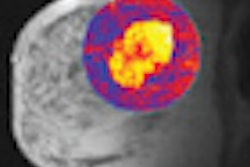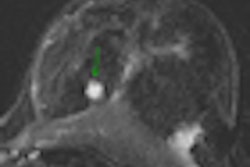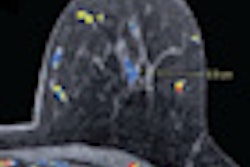Breast cancer screening with MRI can find invasive cancers missed by mammography in women who've had radiation therapy to the chest for other conditions such as Hodgkin's lymphoma, according to a new study published online today in Radiology.
Using MRI to screen for breast cancer could help this population, which faces a greater risk of the disease, the researchers from Memorial Sloan-Kettering Cancer Center in New York City wrote.
The incidence of breast cancer increases eight years after chest irradiation, and 13% to 20% of women who received moderate to high doses of chest irradiation for pediatric cancer will be diagnosed with breast cancer by age 40 to 45. In contrast, the cumulative incidence rate of invasive breast cancer by age 45 among women in the general population is 1%, according to lead author Janice Sung, MD, and colleagues (Radiology, February 15, 2011).
However, while adding breast MRI screening to mammography in women who've had chest radiation therapy for other conditions is recommended by the American Cancer Society, the American College of Radiology, the Society of Breast Imaging, and the Children's Oncology Group, the efficacy of screening breast MRI for this subset of women has not been demonstrated, they wrote.
Sung and colleagues reviewed screening breast MRI exams performed at the center between January 1999 and December 2008 in women with a history of chest irradiation. They looked at data from 247 screening breast MRI studies in 91 women, focusing on number of cancers diagnosed, method of detection, and tumor characteristics.
Sung's team found 10 cancers during the study period. MRI alone detected four, all of which were invasive. MRI and mammography detected three, and mammography alone detected three. The four cancers detected with MRI alone were invasive, while the three cancers detected with mammography alone were in their early stages (two ductal carcinoma in situ [DCIS] and one DCIS with microinvasion). There was no relationship between breast density and the modality with which the cancer was detected, the team found.
The combination of MRI and mammography for women with previous chest irradiation produced the highest breast cancer detection sensitivity: Using the two modalities together resulted in a 4.4% incremental cancer detection rate.
Unfortunately, MRI is not being used in this population to its full effect. One recent study surveying women treated with chest irradiation between the ages of 25 and 50 years in the U.S. and Canada found that almost 50% of women ages 25 to 39 had never undergone mammography and less than 2% had received screening breast MRI, Sung and colleagues wrote.
"Very few women ages 40 to 50 with a history of chest irradiation have undergone screening breast MRIs," according to Sung. "Lack of awareness and limited insurance coverage are possible reasons."
By Kate Madden Yee
AuntMinnie.com staff writer
February 15, 2011



















